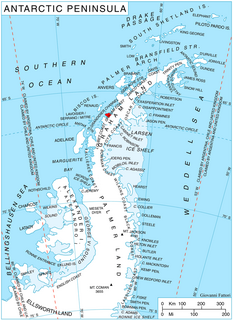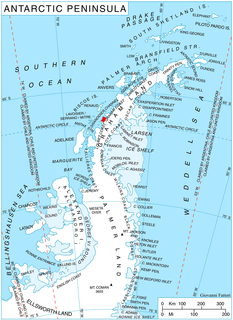
Galindez Island is an island 0.8 kilometres (0.5 mi) long, lying immediately east of Winter Island in the Argentine Islands, Wilhelm Archipelago. It was discovered by the French Antarctic Expedition, 1903–05, under Jean-Baptiste Charcot, who named it for Commander Ismael Galindez of the Argentine Navy, who was dispatched in the Uruguay to search for Charcot, when the expedition was feared lost early in 1905. The island was recharted by the British Graham Land Expedition (BGLE) under John Riddoch Rymill, 1934–37.
The Berthelot Islands are a group of rocky islands, the largest 2 km (1 mi) long, lying 3 km (2 mi) south-west of Deliverance Point, off the west coast of Graham Land, Antarctica. They were discovered by the French Antarctic Expedition, 1903–05, under Jean-Baptiste Charcot, and named by him for Marcellin Berthelot, a prominent French chemist. One of the group, Green Island, is protected as Antarctic Specially Protected Area (ASPA) No.108 because of its relatively luxuriant vegetation and large Antarctic shag colony.

Birley Glacier is a glacier, at least 10 nautical miles (19 km) long, flowing west into the eastern extremity of Barilari Bay north of Vardun Point, on the west coast of Graham Land. First seen and roughly surveyed in 1909 by the French Antarctic Expedition under Jean-Baptiste Charcot, it was re-surveyed in 1935–36 by the British Graham Land Expedition (BGLE) under John Rymill, and later named for Kenneth P. Birley, who contributed toward the cost of the BGLE, 1934–37.

Cadman Glacier is a glacier, 1.5 nautical miles (3 km) wide at its mouth and about 7 nautical miles (13 km) long, flowing northwestward into the head of the southern arm of Beascochea Bay south of Plas Point on the west side of the Antarctic Peninsula.
Port Charcot is a 3 km (1.9 mi) wide bay indenting the north shore of Booth Island, in the Wilhelm Archipelago of Antarctica. It was charted by the third French Antarctic expedition (1903–05), under Jean-Baptiste Charcot, and named by him for his father, Jean-Martin Charcot, French neurologist. Charcot established the expedition's winter base at Port Charcot in 1904.
Mount Chevreux is a mountain, 1,615 metres (5,300 ft) high, standing 5 nautical miles (9 km) southeast of Leroux Bay on the west coast of Graham Land. It was discovered by the French Antarctic Expedition, 1908–10, under Jean-Baptiste Charcot, who named it for Edouard Chevreux, a French zoologist.
Mount Waugh is a mountain, 585 m, standing at the south side of Beascochea Bay 3.5 nautical miles (6 km) northeast of Nunez Point, on the west coast of Graham Land. First charted by the French Antarctic Expedition under Charcot, 1908-10. Named by the United Kingdom Antarctic Place-Names Committee (UK-APC) in 1959 for W.A. Waugh, American biochemist who, with Charles Glen King, first identified the antiscorbutic component from lemon juice, making possible the production of synthetic vitamin C to prevent scurvy, in 1932.
Jeanne Hill is a hill, 195 metres (640 ft) high, standing 0.25 nautical miles (0.5 km) northwest of Mount Guéguen and overlooking Port Charcot on Booth Island, in the Wilhelm Archipelago, Antarctica. It was discovered by the French Antarctic Expedition, 1903–05, under Dr. Jean-Baptiste Charcot, and named by him for his sister.
Depeaux Point is a point forming the south end of Petermann Island, in the Wilhelm Archipelago. It was discovered and named by the French Antarctic Expedition, 1908–10, under Jean-Baptiste Charcot.
Guéguen Point is a point forming the south end of Hovgaard Island, in the Wilhelm Archipelago, Antarctica. It was charted and named by the French Antarctic Expedition, 1903–05, under Jean-Baptiste Charcot, after J. Guéguen, one of the crew the ship Français and later, of the Pourquoi Pas?, 1908–10.

Cape Garcia is a cape at the north side of the entrance to Barilari Bay, forming the north extremity of Felipe Solo (Obligado) Peninsula on the west coast of Graham Land, Antarctica. The cape was discovered and named "Cap Loqui" by the French Antarctic Expedition, 1903–05, under Jean-Baptiste Charcot. At the same time Charcot named the south entrance point to the bay "Cap Garcia," after Rear Admiral Garcia of the Argentine Navy. The maps of Charcot's French Antarctic Expedition, 1908–10, showed "Cap Garcia" as the north cape of Barilari Bay and the name has since become established for this feature. Charcot did not use the name "Cap Loqui" on the maps of his second expedition but, for the sake of historical continuity, the name Loqui Point has been accepted for the south entrance point.

Loqui Point is a point at the northern extremity of Velingrad Peninsula on the west coast of Graham Land, Antarctica. It marks the south side of the entrance to Barilari Bay. This feature was discovered and named "Cap Garcia" by the French Antarctic Expedition, 1903–05, under Jean-Baptiste Charcot. At the same time Charcot gave the name "Cap Loqui" to the north cape of Barilari Bay, after a Captain Loqui of the Argentine Navy. The maps of Charcot's French Antarctic Expedition of 1908–10, showed "Cap Garcia" as the north cape of Barilari Bay, and the name Cape Garcia has since become established in that position. Charcot did not use the name "Cap Loqui" on the maps of the 1908–10 expedition, and with his shifting of the name Cape Garcia, this south entrance point to Barilari Bay had remained unnamed. For the sake of historical continuity, the name Loqui Point was accepted for this feature in the 1950s.
Liouville Point is a point marking the northeast end of Petermann Island, in the Wilhelm Archipelago, Antarctica. It was discovered by the French Antarctic Expedition, 1908–10, and named by Jean-Baptiste Charcot for J. Liouville, assistant medical officer and zoologist of the expedition.
Hervéou Point is a point forming the western extremity of the rocky peninsula between Port Charcot and Salpetriere Bay, on the west side of Booth Island in the Wilhelm Archipelago, Antarctica. It was first charted by the French Antarctic Expedition, 1903–05, under Jean-Baptiste Charcot, and named by him for F. Hervéou, a seaman on the Français.
The Magnier Peaks are two mountain peaks, the higher at 1,345 metres (4,410 ft), surmounting the peninsula between Leroux Bay and Bigo Bay on the west coast of Graham Land, Antarctica. These peaks were discovered and named by the Fourth French Antarctic Expedition, 1908–10, under Jean-Baptiste Charcot.
Maignan Point is a point marking the northeast end of Cholet Island and the west side of the entrance to Port Charcot, lying close off the northwest part of Booth Island in the Wilhelm Archipelago, Antarctica. It was first charted by the Third French Antarctic Expedition, 1903–05, and named by Jean-Baptiste Charcot for F. Maignan, a seaman of the Français who lost his life in a ship accident shortly after the expedition's departure from Le Havre.

Marie Island is an island 2 nautical miles (4 km) long, which lies immediately north of Cape Evensen on the northwest coast of Stresher Peninsula in Graham Land, Antarctica. The name "Pointe Marie," after the elder sister of Dr. Jean-Baptiste Charcot, was applied by the Third French Antarctic Expedition (1903–05) to a point on the coast close north of Cape Evensen. After the Fourth French Antarctic Expedition (1908–10) Charcot re-applied the name to the southern tip of an island, "Ile Waldeck-Rousseau," in approximately the same latitude. Correlating its survey with those of Charcot, the British Graham Land Expedition (1934–37) identified "Ile Waldeck-Rousseau" as Waldeck-Rousseau Peak on the mainland. The most prominent feature near the peak requiring a name is this island, and the name "Marie Island" preserves Charcot's naming in the locality.
Lumière Peak is a peak, 1,065 metres (3,500 ft) high, standing 3 nautical miles (6 km) southeast of Cape Tuxen on the west coast of Graham Land, Antarctica. It was discovered by the Third French Antarctic Expedition, 1903–05, and named by Jean-Baptiste Charcot for Louis Lumière, a leader in photographic research and development in France at that time.
Roullin Point is a point marking the south tip of Booth Island, in the Wilhelm Archipelago. Probably first seen by the German expedition under Dallmann, 1873-74. Charted by the French Antarctic Expedition, 1903-05 under Charcot, and named by him for Captain Roullin, French Navy.

Leroux Bay is a bay 9 nautical miles (17 km) long in a northwest–southeast direction and averaging 5 nautical miles (9 km) wide, between Nunez Point and the narrow Magnier Peninsula surmounted by the Magnier Peaks and Lisiya Ridge, along the west coast of Graham Land, Antarctica. The glaciers Chernomen, Luke and Muldava feed the bay.









